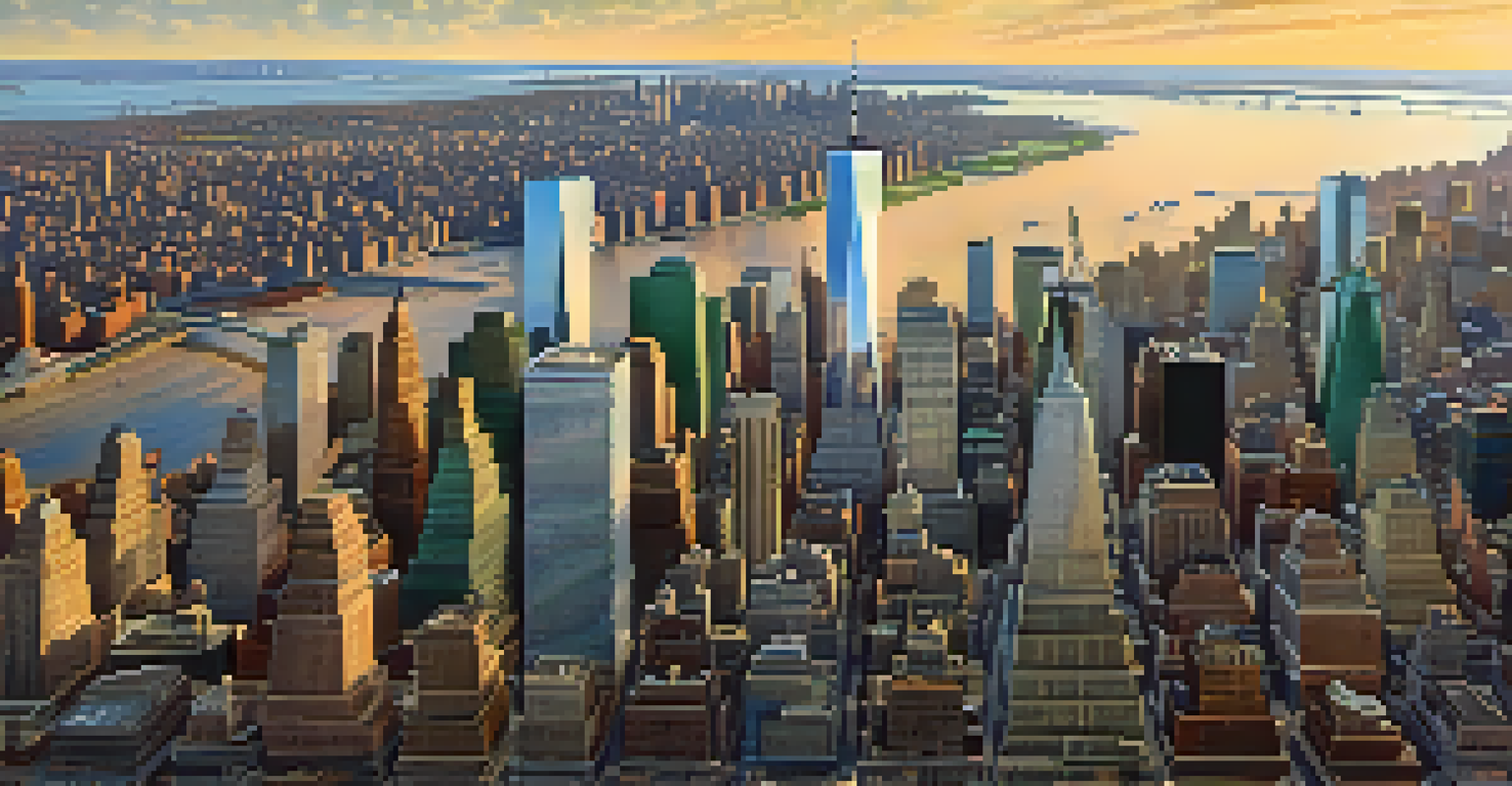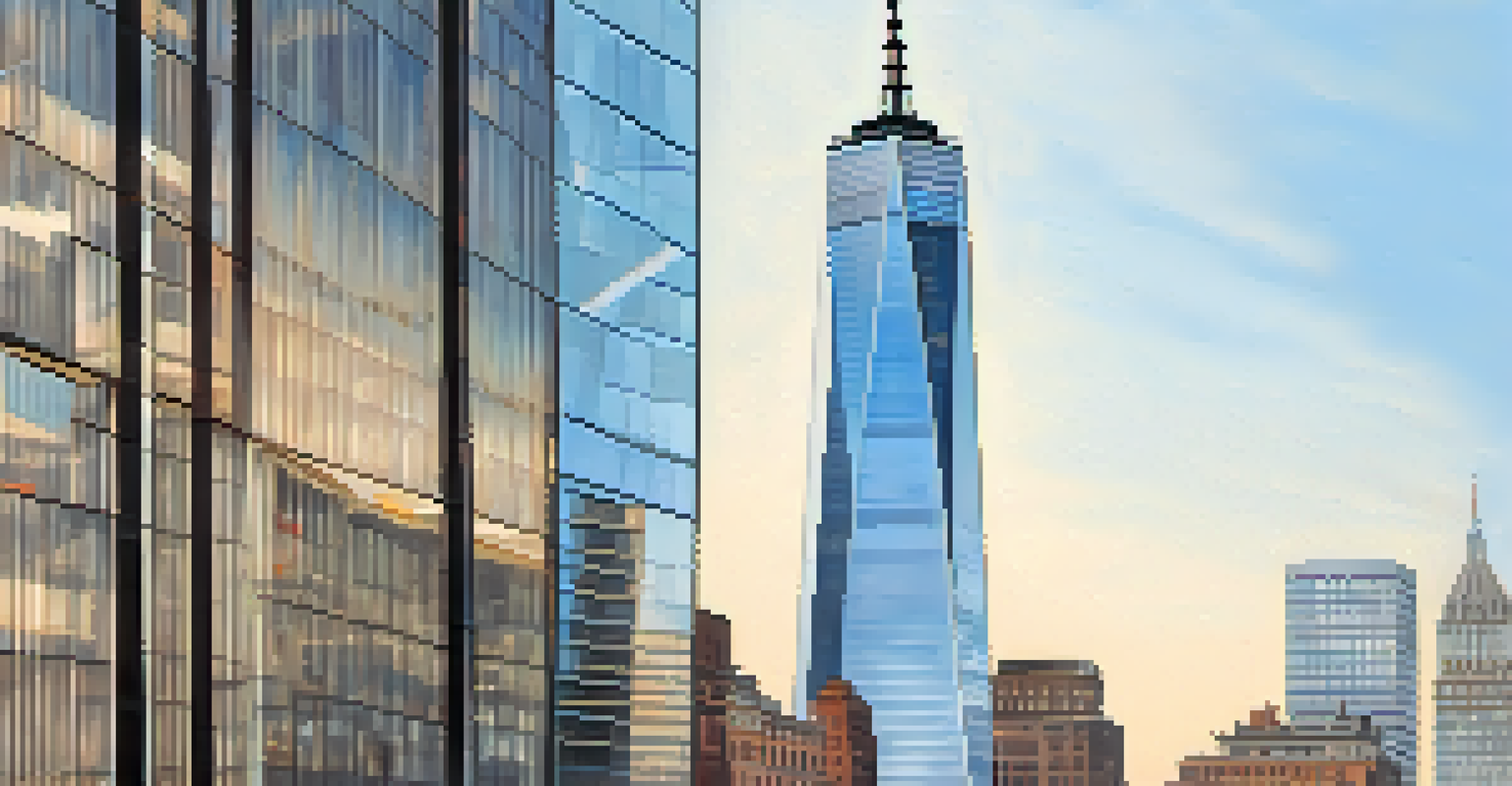The Transformation of NYC’s Skyline: One World Trade Center

A Brief History of the World Trade Center
The original World Trade Center, completed in 1973, was an iconic part of New York City's skyline. It comprised two towering structures known as the Twin Towers, which stood as symbols of prosperity and international trade. However, that changed dramatically on September 11, 2001, when the towers were tragically destroyed in a terrorist attack, leaving a profound impact on the city and the world.
The future belongs to those who believe in the beauty of their dreams.
In the wake of this tragedy, the site became a focal point for reflection, mourning, and ultimately, renewal. The decision to rebuild sparked intense discussions about what the new structures should represent. The vision for the new World Trade Center was not just about replacing the lost towers but also about creating a space that honored the past while looking toward the future.
This led to a new architectural dialogue in NYC, with various designs being proposed. Ultimately, the decision to construct One World Trade Center became a beacon of resilience and hope, symbolizing the city’s determination to rise again from the ashes of destruction.
The Vision Behind One World Trade Center
One World Trade Center, often referred to as the 'One,' was designed by architect David Childs of Skidmore, Owings & Merrill. The building is not only a marvel of modern engineering but also a tribute to the resilience of New Yorkers. Standing at 1,776 feet, it symbolizes the year of America's independence, intertwining history with contemporary architecture.

The design reflects a commitment to sustainability and safety, incorporating advanced technology and materials. For example, the building features a sophisticated high-performance glass facade that maximizes natural light while minimizing energy use. This focus on environmental responsibility has made it a standout example of green architecture in a bustling urban setting.
Resilience Symbolized in Architecture
One World Trade Center stands as a testament to New York City's resilience, blending modern design with historical significance.
Moreover, the building's tiered design creates a unique silhouette against the skyline, differentiating it from other skyscrapers. This attention to aesthetics and functionality has made One World Trade Center an iconic landmark, drawing visitors from around the globe who wish to experience its beauty and significance.
Architectural Features That Stand Out
One World Trade Center boasts several architectural features that make it a standout structure. Its unique base, which expands outward, symbolizes the strength and resilience of the city. This design not only enhances the stability of the building but also provides a sense of openness and accessibility, inviting people to engage with the space.
Out of adversity comes opportunity.
The building's spire, reaching 1,776 feet, is another striking feature that serves both a practical and symbolic purpose. It houses telecommunications equipment while also acting as a beacon visible from miles away. This combination of functionality and symbolism speaks to the heart of the building's design philosophy.
Additionally, the observation deck on the 100th to 102nd floors offers breathtaking views of New York City, providing visitors with an unforgettable experience. This space not only connects people with the city’s skyline but also serves as a reminder of the resilience and revival of a community that once faced immense loss.
The Role of One World Trade Center in NYC's Economy
One World Trade Center plays a key role in New York City's economy, serving as a hub for businesses and organizations. It houses major tenants, including financial institutions, tech companies, and media firms, which contribute to the city's vibrant economic landscape. This influx of businesses has not only revitalized the area but also created thousands of jobs for New Yorkers.
Moreover, the presence of One World Trade Center has spurred further development in Lower Manhattan, attracting new businesses and residents alike. This revitalization is evident in the flourishing dining, shopping, and cultural options available in the area. As a result, the neighborhood has transformed into a bustling center of activity, drawing both locals and tourists.
Economic Hub for Growth and Jobs
The building plays a crucial role in revitalizing Lower Manhattan's economy, attracting businesses and creating thousands of jobs.
The building has also become a symbol of economic resilience, showcasing how NYC can rebound from crisis. As businesses thrive in this iconic space, it reinforces the idea that the city is not just recovering but is poised for future growth and innovation, making it an attractive destination for investment.
Cultural Significance of One World Trade Center
Beyond its economic impact, One World Trade Center holds profound cultural significance. It stands as a monument to the lives lost on 9/11, serving as a space for remembrance and reflection. The design incorporates elements that honor the memory of those who perished, ensuring that the site remains a place of healing for families and the community.
The surrounding area, including the 9/11 Memorial and Museum, complements the building's purpose by providing educational experiences for visitors. These spaces encourage discussions about resilience, unity, and the importance of peace in a world that often feels divided. This cultural dialogue is essential in fostering understanding and connection among people from diverse backgrounds.
Additionally, One World Trade Center has become a popular destination for cultural events and exhibitions, celebrating art and history. By hosting various programs, it continues to play a vital role in New York City's cultural landscape, reminding us of the importance of community and shared experiences.
Public Perception and Visitor Experience
Public perception of One World Trade Center is a blend of admiration and reflection. Many view it as a symbol of hope and resilience, while others remember the tragedy that it memorializes. This duality creates a unique atmosphere around the building, where visitors are encouraged to engage with both its beauty and its history.
Visitors to the observation deck often express awe at the panoramic views and the sense of connection they feel to the city. It offers a vantage point that showcases the vastness of NYC, reminding people of its bustling energy and vibrant life. This experience is often accompanied by a sense of pride in being part of a city that has overcome adversity.
Cultural Landmark for Reflection
One World Trade Center serves as a monument for remembrance and healing, fostering cultural dialogue and community connection.
Moreover, the building has successfully positioned itself as an educational resource, offering guided tours and information about its significance. This focus on visitor experience helps to foster a deeper understanding of the site’s history, encouraging people to reflect on its importance in shaping not only NYC but also the national narrative.
The Future of One World Trade Center and NYC's Skyline
Looking ahead, One World Trade Center is poised to continue its legacy as a transformative force in New York City’s skyline. As the city evolves, the building will likely adapt to meet the changing needs of its tenants and visitors alike. This flexibility is crucial in ensuring that it remains relevant in an ever-changing urban landscape.
Furthermore, the skyline itself is continuously evolving, with new projects being planned and constructed. One World Trade Center stands as a catalyst for this growth, inspiring architects and developers to push the boundaries of design and sustainability. Its presence encourages innovation, reflecting the dynamic spirit of New York City.

Ultimately, One World Trade Center is more than just a building; it represents the resilience of a city and its people. As NYC continues to grow and thrive, this iconic landmark will undoubtedly remain a central part of its identity, reminding future generations of the strength and courage that can emerge from tragedy.